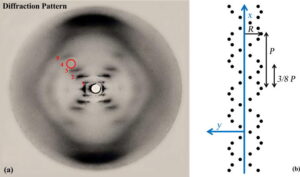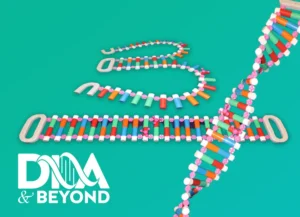While the existence of DNA had been known to scientists for decades, its precise structure remained an elusive puzzle. This mystery was brilliantly solved in 1953 when James Watson and Francis Crick, working at the renowned Cavendish Laboratory in Cambridge, England, made their groundbreaking discovery: the elegant double helix structure, often visualized as a “twisting ladder.”
Their breakthrough was built upon crucial X-ray diffraction images of DNA generated by Rosalind Franklin and Maurice Wilkins. This pivotal finding acted as the key that unlocked a cascade of research into the fundamental mechanisms of life.

The well-known Photo 51, the diffraction pattern from DNA in its so-called B configuration. The dimensions of DNA are: pitch P = 3.4 nm, radius R = 1 nm, and a phase difference between the two helices (sine waves) of ΔP = 3P/8. Several important features include the characteristic X-shape or distorted rhombus, the ten diffracted orders per X, and the missing fourth order. (b) A two-dimensional projection of the phosphate molecules in the DNA backbone. The projection outlines two sine waves.
The momentous revelation was shared informally by Watson and Crick over lunch at the historic “Eagle Pub,” near King’s College, Cambridge, in February 1953. Their understated announcement – that they had found “the secret of life” – hinted at the profound implications of their work. The scientific community was formally introduced to their findings just two months later, with the publication of their seminal paper on April 25th in the prestigious British journal Nature.
In recognition of this landmark achievement and its enduring impact – which revolutionized fields from understanding genetic diseases to the development of genetic engineering – April 25th is celebrated internationally as DNA Day!
Watson and Crick’s discovery opened a floodgate of research worldwide, propelling the field of molecular biology into a new era. Many previously baffling aspects of genetic inheritance came into focus, including the crucial roles played by DNA’s close molecular cousin, ribonucleic acid (RNA). Unlike DNA’s double-stranded structure, RNA typically exists as a single strand, sometimes referred to as a “half ladder.” We will delve deeper into the fascinating world of RNA and its diverse functions in the units that follow.


